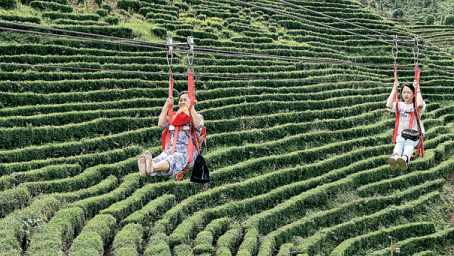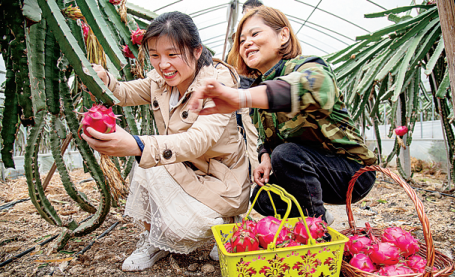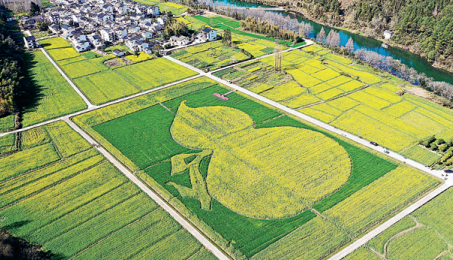As tourism continues to fuel China's rural revitalization drive, fun-packed getaways and the wellness travel sector are booming, Yang Feiyue reports.
Culture and tourism have given rural development a shot in the arm and brought significant changes to local life.
More than 100,000 travelers annually flock to Bama Yao autonomous county in the Guangxi Zhuang autonomous region to enjoy the therapeutical air and natural environment, which has brought an improvement in the lives of villagers, who once struggled with poverty.
Deng Yongkang has been doing good business at his Renshou retreat, which has integrated healthy food, ethnic Yao acrobatic performances, a bamboo forest and rice paddies.
"People have been visiting in huge numbers as the county is widely considered to be an ideal location for health and wellness," Deng says.
Renshou retreat takes in 400,000 traveler visits every year, and has, to date, helped more than 50 rural households develop homestay businesses.
Average rural household income has increased by 30,000 yuan ($4,722) a year, according to the local authority.
Tourism has become a pillar industry for the county, which shook off poverty in 2019.
The county received more than 4.2 million tourist visits during the first six months of last year, and more than 36,000 villagers have managed to make a living via health and wellness tourism.
"We will further tap into the potential of Bama's health tourism and traditional medicine, and turn it into a world-class destination for the sector," says Huang Bingfeng, Party secretary of Bama.

Shanggantang village in Yongzhou, Hunan province, draws visitors with its ancient buildings nestled among the hills. JIANG KEQING/FOR CHINA DAILY
Since China's top legislature passed a law that promotes the national rural vitalization strategy, which came into force on June 1 last year, tourism operators have also made inroads into rural development, and play an increasingly important role in improving villagers' lives.
The law features provisions ranging from attracting talent and boosting rural industries, to preserving ecology.
Liang Jianzhang, co-founder of China's major online travel agency, Trip.com Group, believes opportunities for homestay development lie in the rural area.
"Last year marked the beginning of the 14th Five-Year Plan (2021-25), and rural vitalization's strategic position is increasingly prominent," Liang says.
"I believe rural tourism will be a golden key to rural vitalization."
Since March last year, the agency has developed eight rural retreats in Anhui, Henan, Jiangxi and Hunan provinces, as well as the Xinjiang Uygur autonomous region.
The first one, at Dawan village, Anhui province, began operations on July 3 and the rural resorts proved popular among travelers during the National Day holiday in October.
Some reported occupancy rates of more than 90 percent up to 15 days ahead of the holiday, according to the agency.
In Xinjiang, the facility in Hemu village, Burqin county in Altay, enables travelers to commune with nature through the vast grasslands that are surrounded by mountain ranges and are imbued with a strong nomadic culture.
The facility features five courtyards and 11 homestays and includes a garden area of more than 10,000 square meters. The company helped locals to renovate their houses for tourism purposes, secure tour-service jobs and sell their farm produce.

A rope slide allows tourists to enjoy a unique view of a tea plantation in Gulou village in Shaoyang, Hunan province. TENG ZHIZHONG/FOR CHINA DAILY
To date, half of the resort's employees are local villagers.
The buildings and decorations go beyond local requirements for environmental protection, says Chen Kong, who is in charge of the operation of the facility.
The stone used in the construction is locally sourced, and wooden materials are certified by the Forest Stewardship Council, an international nonprofit organization that promotes responsible management of the world's forests.
"During our team building events, we'll arrange for employees to go out and clean up the garbage discarded by tourists," Chen says.
This is all part of Trip.com Group's plan to set up a 1 billion yuan fund to build model destinations in the country's rural areas. In particular, 10 high-end rural retreats are at the heart of the strategy.
A total of 100 tourism villages and 10,000 rural tourism staff will be developed over the next five years, according to the online travel agency.
The June legislation has also made the Chinese Farmers' Harvest Festival a statutory holiday on the day of the autumn equinox, which usually falls in September, in an attempt to vitalize rural culture.
Modern agricultural exhibitions and rural food appreciation events are expected to draw many visitors, experts say.
The lively and popular activities will stimulate the passion of the farmers and residents, says Ma Youxiang, vice-minister of the agriculture and rural affairs.
Last year's celebrations covered major events along the Yangtze River Economic Belt on Sept 23, and integrated farming culture, as well as displaying cultural resources with local and ethnic characteristics.
Cultural activities such as farmers' concerts, rural photography, calligraphy and painting were in place.
In 2019, the rural tourism sector saw 3.3 billion traveler visits, with operating revenue exceeding 850 billion yuan, according to the Ministry of Agriculture and Rural Affairs. It has shown a strong recovery since the downturn caused by the pandemic.
In the first six months of last year, the number of tourists to Beijing's rural areas recovered to 66.1 percent of that of the same period in 2019, and business revenue has recovered to some 90 percent, according to the local authority.
At a national promotion meeting for high-quality rural industry development by the ministry in March last year, it was announced that the country will strive to achieve more than 4 billion travel visits to rural villages by 2025, with operating revenue breaking 1.2 trillion yuan. It is expected to benefit more than 15 million people.
Such promises have seen other tour players make inroads in rural tourism development.
The culture and tourism conglomerate Overseas Chinese Town Group has deepened strategic cooperation with rural areas in Guizhou, Sichuan and Gansu provinces to improve local folk customs and the local environment, as well as tap into local culture and tourism resources.
The OCT Group has developed about 30 distinctive rural projects across the country, including the Beijing-Tianjin-Hebei region, the Yangtze River Delta, Hainan and Yunnan provinces.
Those scenic spots have received 40 million tourist visits annually on average, bringing 160,000 people out of poverty, according to OCT.
Since 2016, at Zhongliao village in Hainan, local ethnic Li elements have been retained as part of the construction of a pastoral getaway and art performance venue by the group.

Having fun picking dragon fruit in Sanbushi village in Jinhua, Zhejiang province. HU XIAOFEI/FOR CHINA DAILY
"Our living environment has improved, and tourism has been all the rage in the village," says Su Yingnuan, a Zhongliao resident.
"We can enjoy employment on our doorsteps and an increase in income, so we all feel happy," Su says.
At Xiaopuxi village, Xishuangbanna Dai autonomous prefecture in Yunnan, a health preservation facility featuring tea tours has drawn travelers from far and wide. The village is home to the Jino ethnic group.
The development by OCT Group has given the previously poor village a facelift, says Bai Chunguo, a village official.
"The tea trees on the mountain and the Jino culture have brought us development opportunities. Villagers can receive friends from all over the world without leaving the village," Bai says.
Apart from tourism, culture has also made its presence felt in improving rural conditions.
The General Office of the Communist Party of China Central Committee and the General Office of the State Council released a guideline to strengthen the protection of the country's intangible cultural heritage in August.
The country will work on improving the system of intangible cultural heritage inheritors and encourage the integration of intangible cultural heritage into tourism on the premise of effective preservation, according to the guideline. Efforts will be stepped up to spread and popularize intangible cultural heritage. Financial support to intangible cultural heritage protection is also offered, including government funds for intangible cultural heritage preservation, as well as interest discounts for loans and tax incentives.
"It was a very substantial protective policy, and many vocational schools now offer training classes for intangible cultural heritage skills," says Tian Jing, a member of the CPPCC National Committee and an inheritor of the national intangible culture heritage, purple pottery firing from Jianshui county, Yunnan province.
Jianshui's purple pottery is made from the local "five-color" clay. It flourished during the Qing Dynasty (1644-1911).
At last year's two sessions, Tian proposed to increase the number of intangible cultural heritage teachers at medium-level vocational schools in ethnic group-inhabited areas and to build national intangible cultural heritage digital museums.
"Both proposals have made an advancement," Tian says.
In 2018, the Ministry of Culture and Tourism and the National Rural Revitalization Administration issued guidelines that support the founding of intangible cultural heritage workshops to create job opportunities and teach traditional art skills to people who were overcoming poverty.
Tian established a purple pottery learning center in 2018 and has given training to more than 100 women from rural areas in the art that she has been studying since she was 17.
To date, more than 40,000 people in Jianshui county are involved in the purple pottery industry, which has evolved to have an output value of more than 4 billion yuan.
"Intangible cultural heritage can lend support to rural vitalization through having young people return home and pick up distinctive traditional crafts, thus increasing job and entrepreneurship opportunities," Tian explains.
In December last year, the Ministry of Culture and Tourism, the Ministry of Human Resources and Social Security, and the National Rural Revitalization Administration jointly issued a notice that they would continue to push forward development of intangible cultural heritage workshops to strengthen related culture protection and increase employment opportunities and rural income.
Niu Chengguo from Beijing's Shunyi district says that he is thrilled at those positive policies in favor of intangible heritage development.
For more than 40 years, the 56-year-old villager has engaged in making fire-painted bottle gourd artworks, which was named an intangible heritage item by the Beijing government in September 2021.
"With all this good news, we just feel more motivated than ever to forge further ahead on our intangible cultural heritage journey," he says.

A field of rapeseed flower is cultivated into the pattern of a gourd in Nankeng village, Huangshan, Anhui province. SHI YALEI/FOR CHINA DAILY














